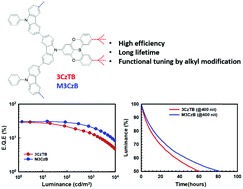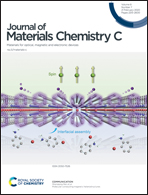Highly efficient blue thermally activated delayed fluorescence organic light emitting diodes based on tercarbazole donor and boron acceptor dyads†
Abstract
Two new blue TADF emitters, namely, 9′-(2,12-di-tert-butyl-5,9-dioxa-13b-boranaphtho[3,2,1-de]anthracen-7-yl)-9,9′′-diphenyl-9H,9′H,9′′H-3,3′:6′,3′′-tercarbazole (3CzTB) and 9′-(5,9-dioxa-13b-boranaphtho[3,2,1-de]anthracen-7-yl)-6,6′′-dimethyl-9,9′′-diphenyl-9H,9′H,9′′H-3,3′:6′,3′′-tercarbazole (M3CzB), for application in highly efficient organic light-emitting diodes are reported. These emitters consist of tercarbazole as donor and rigid oxygen bridged boron as acceptor units. Despite having the same donor and acceptor segments, an alkyl modification on the periphery of the donor and acceptor units altered their physicochemical properties and the electrochemical stability of the emitters. Blue TADF light-emitting devices fabricated with these emitters exhibited a maximum external quantum efficiency (EQE) and luminance of 30.7%, 18 160 cd m−2 and 29.1%, 11 690 cd m−2 for M3CzB and 3CzTB, respectively. The operational lifetime (LT50) of the stable blue TADF device fabricated with these emitters was 81 h and 60.5 h at 400 nits with the maximum EQE and CIE color coordinates of 14.4%, (0.13, 0.19) and 7.6%, (0.14, 0.10) for M3CzB and 3CzTB, respectively.

- This article is part of the themed collection: Journal of Materials Chemistry C Lunar New Year collection 2021


 Please wait while we load your content...
Please wait while we load your content...